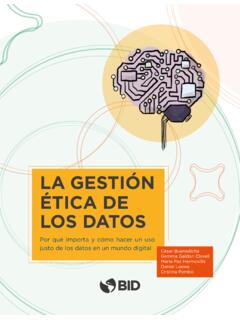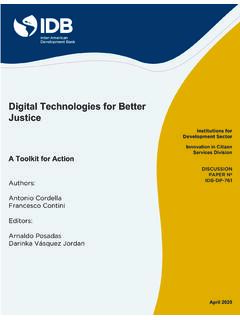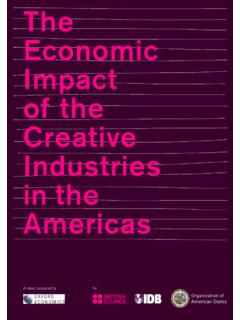Transcription of Designing Impact Evaluations for Agricultural Projects
1 Designing Impact Evaluations for Agricultural ProjectsImpact-Evaluation GuidelinesTechnical NotesNo. IDB-TN-198 December 2010 Paul Winters Lina Salazar Alessandro Maffioli Office of Strategic Planning and Development Effectiveness, Inter-American Development BankDesigning Impact Evaluations for Agricultural ProjectsImpact-Evaluation GuidelinesPaul Winters Lina Salazar Alessandro Maffioli Inter-American Development Bank2010 The Inter-American Development Bank Technical Notes encompass a wide range of best practices, project Evaluations , lessons learned, case studies, methodological notes, and other documents of a technical nature.
2 The information and opinions presented in these publications are entirely those of the author(s), and no endorsement by the Inter-American Development Bank, its Board of Executive Directors, or the countries they represent is expressed or implied. This paper may be freely reproduced. Paul Winters: Lina Salazar: Alessandro Maffioli: Designing Impact Evaluations for Agricultural Projects Abstract Paul Winters Lina Salazar Alessandro Maffioli With input from Boris Bravo-Ureta, Steve Boucher and Conner Mullally** The purpose of this guideline is to provide suggestions on Designing Impact Evaluations for Agricultural Projects , particularly Projects that directly target farmers, and seek to improve Agricultural production, productivity and profitability.
3 Specific issues in evaluating Agricultural Projects are addressed, including the need to use production-based indicators and to carefully consider indirect or spillover effects that are common in Agricultural Projects . The guideline considers the challenges of conducting Impact Evaluations of Agricultural Projects as well as the methods for assessing Impact . Issues of collecting Agricultural data for an Impact evaluation and how to put together the overall design strategy in an evaluation plan are also covered.
4 The guideline concludes with three case studies of Impact Evaluations designed for a technology adoption project in the Dominican Republic, a forestry/technology project in Nicaragua, and a crop insurance project in Peru. JEL Classification: H43, O12, O13, O22, Q12, Q18 KeyWords: Impact Evaluation, Agriculture, Technology Adoption, Development Effectiveness, Dominican Republic, PATCA, Nicaragua, APAGRO, Crop Insurance, Peru, PROCAMPO, Mexico. Associate Professor, Department of Economics, American University, Washington, DC; Research Fellow, Strategy Development Division, Inter-American Development Bank, Washington, DC; Lead Economist, Strategy Development Division, Inter-American Development Bank, Washington, DC; Boris Bravo-Ureta, University of Connecticut; Steve Boucher, University of California at Davis.
5 And Conner Mullally, University of California at Davis. 2 Table of Contents 1. Introduction 6 2. Agricultural Projects and their Expected Impact 9 3. Challenges in Evaluating Agricultural Projects 13 4. Evaluation Design and Methods to Employ 16 Experimental Approaches 17 Challenges in Using Experimental Approaches 22 1. Small Sample Size 22 2. Randomization not Implemented Properly 22 3. Failure to Follow Treatment Protocol 22 4. Attrition and Measurement Error 23 5. Experimental Effects 23 6. Spillover Effects and Contamination 23 Adjusting to Problems 26 Non-experimental Approaches 27 Difference-in-difference 28 Instrumental Variables and Encouragement Design 31 Propensity-score Matching 34 Regression Discontinuity 37 3 Incorporating Spillover Effects 39 Considering the Methodological Options 42 5.
6 Collecting Agricultural Data 44 Designing Data Collection Procedures 45 Timing and Periodicity 45 Pilot Testing and Survey Preparation 48 Questionnaire Design 51 Basic of Sample Design 55 6. Writing an Evaluation Plan 57 7. Case Study: Dominican Republic Technology Adoption Program PATCA II 58 The PATCA II intervention 58 The Logic of the PATCA II Intervention 60 Market Failure and Technology Diffusion Curve 60 Hypotheses to Test and Indicators 64 Evaluation Methodology 67 Selection of Beneficiaries (Annual Randomization in Two Stages) 67 Econometric Analysis 71 Sampling Strategy 73 Data Collection 75 Timing and Periodicity 75 4 Questionnaire 75 Impact Evaluation Budget, Products and Activities 76 Budget 76 Products 76 Timeline and Activities 76 8.
7 Case Study: Nicaraguan APAGRO Program 78 The APAGRO Intervention 78 The Logic of the APAGRO Intervention 80 Hypotheses to test and indicators 82 Program roll out 84 Evaluation Methodology 87 Data Collection Strategy 91 Timing and survey organization 91 Questionnaire 92 Budget and Implementation 93 9. Case Study: Evaluating the Impact of Index Insurance on Cotton Farmers in Peru 95 A primer on Index Insurance 96 The Intervention and Primary Research Hypotheses 98 Hypotheses to be Tested 99 5 Research Design: Randomized Price Encouragement 99 A Basic Econometric Model 100 Implementation in Pisco 105 Choice of Instruments 105 Sample Size Calculations 106 Sample Frame and Sample Selection 108 Household Surveys 108 Budget of Survey Administration 109 Pisco sour?
8 Lessons from a Discouraging Encouragement Design 109 Concluding Remarks 111 References 113 6 1. Introduction While Impact Evaluations have become widespread in the last decade and the methods of Impact evaluation widely known, they are much more common in the social sectors where the indicators of Impact tend to be more easily identifiable and there is a longer history of conducting such Evaluations . With respect to Agricultural Projects , a recent study by the IDB (2010) finds that the coverage of Agricultural Impact Evaluations is limited in most areas and even where there is a greater critical mass of Evaluations , such as in land titling and technology adoption Projects , additional information on these types of interventions would be helpful.
9 This conclusion is mirrored in a recent review of Agricultural Impact Evaluations by Del Carpio and Maredia (2009), which identifies a total of 85 papers that can be defined as true Impact Evaluations ; that is, which attempt to establish a clearly defined counterfactual. Of those, only eight use experimentally designed approaches while the remainder use quasi-experimental or non-experimental approaches, suggesting that few of the Evaluations were designed prior to project implementation. Further, although the papers use evaluation techniques, in many of the cases the papers assess broader changes in rural areas ( expansion of rural banks, contract farming, and new varieties such as Bt cotton) rather than explicit government Agricultural policies or Projects .
10 Overall, Del Carpio and Maredia (2009) conclude that the evidence on the effectiveness of Agricultural Projects in developing countries is quite thin. Although this is the case, the interest in conducting Impact Evaluations of Agricultural Projects has increased, with pressure coming from two quarters. First, economists have increasingly emphasized the use of randomized trials to determine the effectiveness of development assistance (Banerjee, 2007; Duflo and Kremer, 2005). Although there is some debate over whether randomized trials are the only valid approach (Ravallion, 2009), economists seem to agree on the value of carefully collecting data to evaluate the Impact of development Projects and in the importance of using carefully constructed datasets and empirical approaches to identify Impact .












